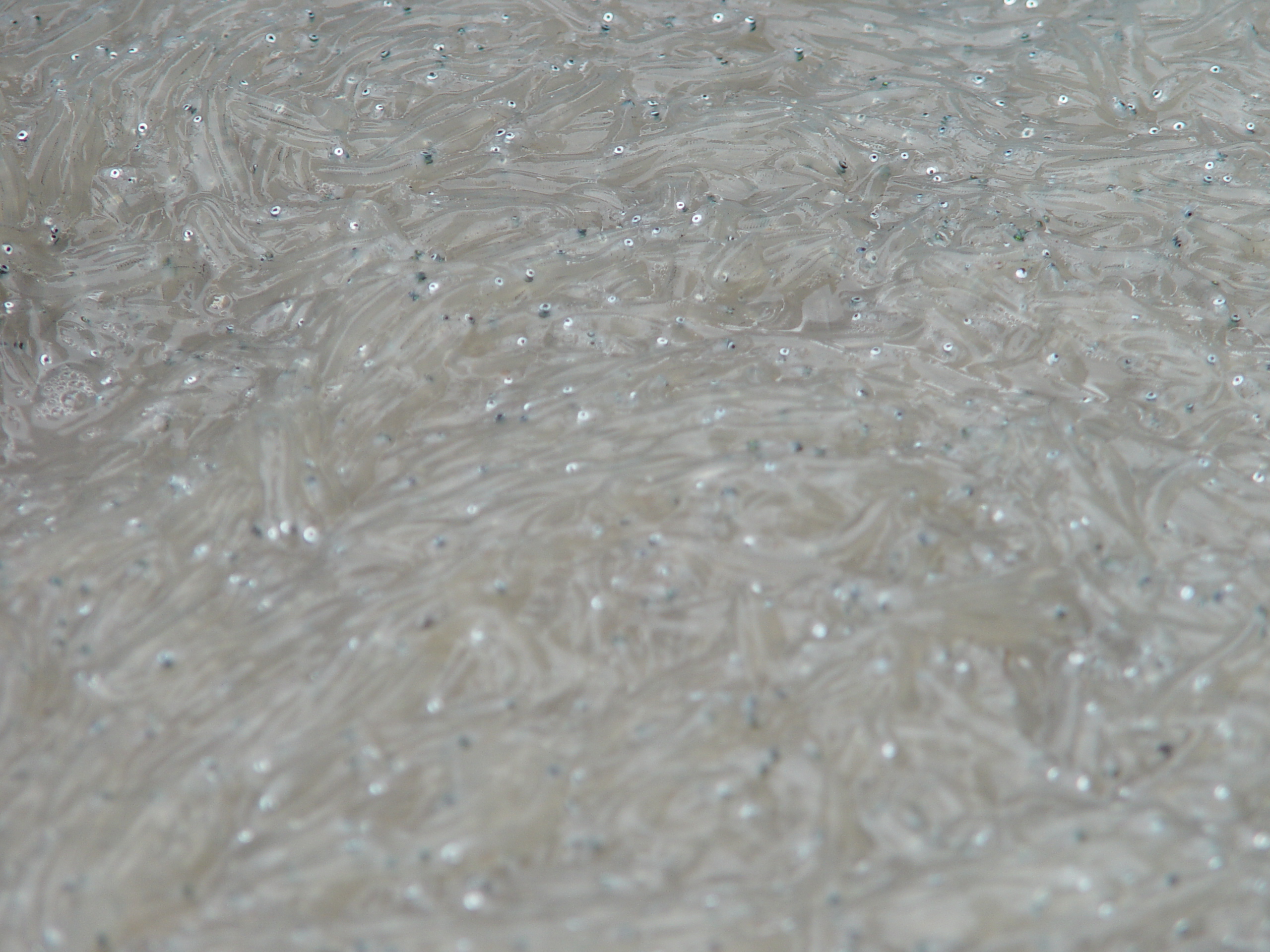|
Kōkopu
Kokopu () is a common name used for three species of ray-finned fish of the genus ''Galaxias''. They are found in the rivers, lakes and swamps of New Zealand, to which they are endemic. Kokopu are galaxiids and like others members of that family lacks scales and has a thick, leathery skin covered with mucus. Kokopu inhabit streams with plenty of cover (e.g. logs and overhanging boulders) but can also be found in swamps and larger waterways. They mostly feed on invertebrates that live in the stream beds but also eat insects that fall into the water and will move into the open at night for feeding. There are three known species of Kokopu in New Zealand: * Giant kōkopu, ''Galaxias argenteus'' * Banded kōkopu, '' Galaxias fasciatus'' * Shortjaw kōkopu, ''Galaxias postvectis'' Kokopu live for between 5 and 10 years but can reach in excess of 21 years. They spawn in leaf debris in stream beds or during spring tides and the eggs hatch about 30 days after being laid. The hatchlin ... [...More Info...] [...Related Items...] OR: [Wikipedia] [Google] [Baidu] |
Giant Kōkopu
The giant kōkopu (''Galaxias argenteus'') is a threatened species of Actinopterygii, ray-finned fish in the genus ''Galaxias'', found only in New Zealand. It can reach up to in length and in weight, making it the largest species in the family Galaxiidae. It is a mainly lowland species, commonly found in slow-flowing streams, wetlands, lakes, and lagoons. Most populations have an amphidromous life cycle, with larvae going to sea soon after hatching and returning about four months later as small juveniles, . Juvenile giant kōkopu form a small part of the annual whitebait catch. Etymology The first species in the family Galaxiidae to be described by scientists, the giant kōkopu was initially placed in the genus ''Esox'' (pikes) by Johann Friedrich Gmelin in 1789. Georges Cuvier, Cuvier recognised that it was not a pike and in 1816 coined the genus name ''Galaxias'' as a reference to its star-like (galaxy) markings. The genus was later expanded to include numerous other specie ... [...More Info...] [...Related Items...] OR: [Wikipedia] [Google] [Baidu] |
Shortjaw Kōkopu
The shortjaw kōkopu (''Galaxias postvectis'') is a galaxiid ray-finned fish, endemic to New Zealand. They are large, scaleless fish which inhabit stable pools in cascading, bouldery streams with forest cover. Shortjaw kōkopu are amphidromous, with the fry going to sea after hatching, and returning as juveniles to fresh water where they grow to adulthood. They may grow to a maximum of in total length, but more commonly reach . The shortjaw kōkopu live in microhabitats that have more large particles at the bed of the body of water (substrates) and more places to seek safety compared to all nearby possible habitats. During the night, they remain in calmer areas like pools, whereas during the day shortjaw kōkopu spend their time in places with large substrates and a more tumultuous water surface, staying in both flow channel and pool habits. In 2023 a newly recorded population of this species was detected in the Kopuawhara catchment north of Māhia Peninsula in Hawkes Bay usin ... [...More Info...] [...Related Items...] OR: [Wikipedia] [Google] [Baidu] |
Whitebait
Whitebait is a collective term for the immature fry of fish, typically between long. Such young fish often travel together in schools along coasts, and move into estuaries and sometimes up rivers where they can be easily caught using fine-meshed fishing nets. Whitebaiting is the activity of catching whitebait. Individual whitebait are tender and edible. The entire fish is eaten — including head, fins, bones, and bowels. Some species make better eating than others, and the particular species that are marketed as "whitebait" vary in different parts of the world. As whitebait consists of immature fry of many important food species (such as herring, sprat, sardines, mackerel, bass and many others) it is not an ecologically viable foodstuff and several countries impose strict controls on harvesting. Whitebait by region Alboran Sea The Alboran Sea is the westernmost element of the Mediterranean Sea. Whitebait have been consumed as a favoured element of the diet of peoples l ... [...More Info...] [...Related Items...] OR: [Wikipedia] [Google] [Baidu] |
Galaxiid
The Galaxiidae are a family of mostly small freshwater fish in the Southern Hemisphere. The majority live in Southern Australia or New Zealand, but some are found in South Africa, southern South America, Lord Howe Island, New Caledonia, and the Falkland Islands. One galaxiid species, the common galaxias (''Galaxias maculatus''), is probably the most widely naturally distributed freshwater fish in the Southern Hemisphere. They are coolwater species, found in temperate latitudes, with only one species known from subtropical habitats. Many specialise in living in cold, high-altitude upland rivers, streams, and lakes. Some galaxiids live in fresh water all their lives, but many have a partially marine lifecycle. In these cases, larvae are hatched in a river, but are washed downstream to the ocean, later returning to rivers as juveniles to complete their development to full adulthood. This pattern differs from that of salmon, which only return to fresh water to breed, and is describ ... [...More Info...] [...Related Items...] OR: [Wikipedia] [Google] [Baidu] |
Acclimatisation Society
Acclimatisation societies were voluntary associations, founded in the 19th and 20th centuries, that encouraged the introduction of non-native species in various places around the world, in the hope that they would acclimatise and adapt to their new environments. The societies formed during the colonial era, when Europeans began to settle in numbers in unfamiliar locations. One motivation for the activities of the acclimatisation societies was that introducing new species of plants and animals (mainly from Europe) would enrich the flora and fauna of target regions. The movement also sought to establish plants and animals that were familiar to Europeans, while also bringing exotic and useful foreign plants and animals to centres of European settlement. It is now widely understood that introducing species to foreign environments is often harmful to native species and to their ecosystems. For example, in Australia the environment was seriously harmed by overgrazing by rabbits. I ... [...More Info...] [...Related Items...] OR: [Wikipedia] [Google] [Baidu] |
National Park
A national park is a nature park designated for conservation (ethic), conservation purposes because of unparalleled national natural, historic, or cultural significance. It is an area of natural, semi-natural, or developed land that is protected and owned by a government. Although governments hold different standards for national park designation, the conservation of 'wild nature' for posterity and as a symbol of national pride is a common motivation for the continued protection of all national parks around the world. National parks are almost always accessible to the public.Gissibl, B., S. Höhler and P. Kupper, 2012, ''Civilizing Nature, National Parks in Global Historical Perspective'', Berghahn, Oxford Usually national parks are developed, owned and managed by national governments, though in some countries with federal government, federal or Devolution, devolved forms of government, "national parks" may be the responsibility of subnational, regional, or local authorities. Th ... [...More Info...] [...Related Items...] OR: [Wikipedia] [Google] [Baidu] |
Biodiversity
Biodiversity is the variability of life, life on Earth. It can be measured on various levels. There is for example genetic variability, species diversity, ecosystem diversity and Phylogenetics, phylogenetic diversity. Diversity is not distributed evenly on Earth. It is greater in the tropics as a result of the warm climate and high primary productivity in the region near the equator. Tropical forest ecosystems cover less than one-fifth of Earth's terrestrial area and contain about 50% of the world's species. There are latitudinal gradients in species diversity for both marine and terrestrial taxa. Since Abiogenesis, life began on Earth, six major mass extinctions and several minor events have led to large and sudden drops in biodiversity. The Phanerozoic aeon (the last 540 million years) marked a rapid growth in biodiversity via the Cambrian explosion. In this period, the majority of Multicellular organism, multicellular Phylum, phyla first appeared. The next 400 mil ... [...More Info...] [...Related Items...] OR: [Wikipedia] [Google] [Baidu] |
Spring Tide
Tides are the rise and fall of sea levels caused by the combined effects of the gravitational forces exerted by the Moon (and to a much lesser extent, the Sun) and are also caused by the Earth and Moon orbiting one another. Tide tables can be used for any given locale to find the predicted times and amplitude (or " tidal range"). The predictions are influenced by many factors including the alignment of the Sun and Moon, the phase and amplitude of the tide (pattern of tides in the deep ocean), the amphidromic systems of the oceans, and the shape of the coastline and near-shore bathymetry (see '' Timing''). They are however only predictions, the actual time and height of the tide is affected by wind and atmospheric pressure. Many shorelines experience semi-diurnal tides—two nearly equal high and low tides each day. Other locations have a diurnal tide—one high and low tide each day. A "mixed tide"—two uneven magnitude tides a day—is a third regular category. ... [...More Info...] [...Related Items...] OR: [Wikipedia] [Google] [Baidu] |
Spawn (biology)
Spawn is the eggs and sperm released or deposited into water by aquatic animals. As a verb, ''to spawn'' refers to the process of freely releasing eggs and sperm into a body of water (fresh or marine); the physical act is known as spawning. The vast majority of aquatic and amphibious animals reproduce through spawning. These include the following groups: * Bony fishes * Crustaceans (such as crabs, shrimps, etc.) *Mollusks (such as oysters, octopus, squid) *Echinoderms (such as sea urchins, sea stars, sea cucumbers, etc.) * Amphibians (such as frogs, toads, salamanders, newts) * Aquatic insects (such as dragonflies, mayflies, mosquitoes) *Coral, which are living colonies of tiny, aquatic organisms—not plants, as they are sometimes perceived to be. Corals, while appearing sedentary or botanical by nature, actually spawn by releasing clouds of sperm and egg cells into the water column, where the two mix. As a general rule, aquatic or semiaquatic reptiles, birds, ... [...More Info...] [...Related Items...] OR: [Wikipedia] [Google] [Baidu] |
Galaxias Postvectis
''Galaxias'' is a genus of small freshwater fish in the family Galaxiidae, and are frequently referred to as the galaxiids. These highly adaptable fish are typically found at temperate latitudes across the Southern Hemisphere. Galaxiids are scaleless and somewhat tubular in body form, ranging from very slender to quite bulky. They are somewhat torpedo-shaped, with the dorsal and anal fins positioned close to the tail. They are generally small, with typical adults ranging between in total length, with some stocky species attaining around . The largest, ''Galaxias argenteus'', has been recorded at , although is a more typical adult length. Species The 46 recognized species in this genus are: * ''Galaxias aequipinnis'' Raadik, 2014 (East Gippsland Galaxias) * '' Galaxias anomalus'' Stokell, 1959 (Roundhead Galaxias) * ''Galaxias arcanus'' Raadik, 2014 (Riffle Galaxias) * ''Galaxias argenteus'' Gmelin, 1789 (Giant Kōkopu) * ''Galaxias auratus'' Johnston, 1883 (Golden Gala ... [...More Info...] [...Related Items...] OR: [Wikipedia] [Google] [Baidu] |




